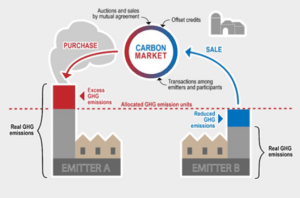Framework for Voluntary Carbon Market in Agriculture Sector
Context:
Recently, the Union Minister unveiled the Framework for Voluntary Carbon Market in Agriculture Sector and the Accreditation Protocol of Agroforestry Nurseries.
Relevance: GS-03 (Agriculture)
Voluntary Carbon Market in Agriculture:
- The Agriculture Ministry has devised a framework to encourage the Voluntary Carbon Market (VCM) within the agricultural sector, aiming to enable small and medium farmers to access carbon credit benefits.
- This initiative not only supports farmers but also fosters the adoption of environmentally sustainable agricultural practices.
- About: Voluntary carbon markets enable carbon emitters to offset their emissions by purchasing carbon credits generated by projects aimed at removing or reducing greenhouse gases from the atmosphere.
- In agriculture, carbon credits are generated based on carbon dioxide absorbed into the soil and greenhouse gas emissions reduced above the soil (e.g., through improved nitrogen timing) – surpassing the existing practices on a farm.
- While agriculture contributes to climate change, it also possesses the capacity to mitigate it by serving as a carbon sink.
- Accreditation Protocol of Agroforestry Nurseries: This protocol aims to enhance the institutional mechanisms for the production and certification of planting material on a large scale to promote agroforestry nationwide.
Carbon Markets Explained:

- Carbon markets serve as a mechanism for pricing carbon emissions, enabling the trade of carbon credits with the overarching aim of reducing emissions.
- These markets offer incentives for emission reduction and energy efficiency improvements, fostering a shift towards cleaner practices.
- For instance, entities exceeding emission standards can earn credits, while those falling short can purchase credits to meet compliance requirements.
- Trading systems are established where carbon credits or allowances can be bought and sold, facilitating emissions reduction efforts.
- A carbon credit represents one tonne of carbon dioxide removed, reduced, or sequestered, as per United Nations standards.
- Governments set carbon allowances or caps based on their emission reduction targets, regulating the overall emission levels.
- Under Article 6 of the Paris Agreement, countries can utilize international carbon markets to meet their Nationally Determined Contributions (NDCs) aimed at achieving net-zero emissions.




